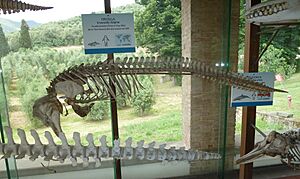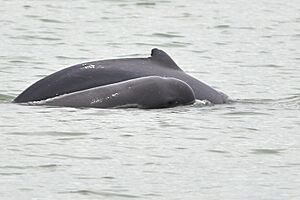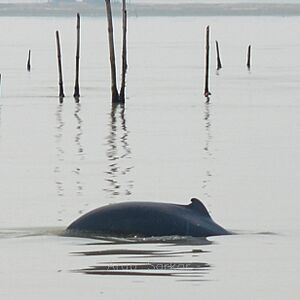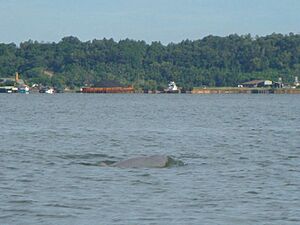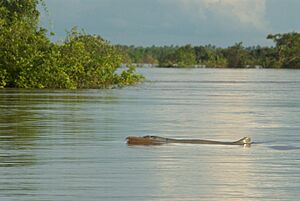Irrawaddy dolphin facts for kids
Quick facts for kids Irrawaddy dolphin |
|
|---|---|
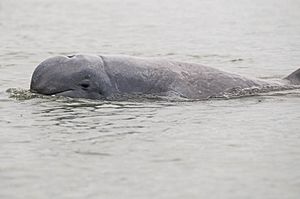 |
|
| Irrawaddy dolphin in Cambodia | |
 |
|
| Size comparison with an average human | |
| Conservation status | |
| Scientific classification | |
| Genus: |
Orcaella
|
| Species: |
brevirostris
|
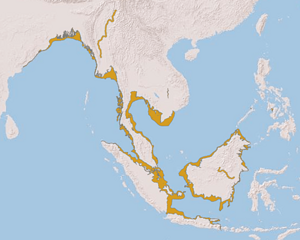 |
|
| Irrawaddy dolphin range in 2017 | |
| Synonyms | |
|
List
Orca (Orcaella) brevirostris Owen in Gray, 1866 (basionym)
Orcaella brevirostris brevirostris Ellerman & Morrison-Scott, 1951 Orcaella brevirostris fluminalis Ellerman & Morrison-Scott, 1951 Orcaella fluminalis Gray, 1871 Orcella brevirostris Anderson, 1871 Orcella fluminalis Anderson, 1871 Phocaena (Orca) brevirostris Owen, 1866 |
|
The Irrawaddy dolphin (Orcaella brevirostris) is a special type of oceanic dolphin. It can live in both salty ocean water and fresh river water, which is called euryhaline. You can find these dolphins in different groups near sea coasts, river mouths, and in rivers across parts of the Bay of Bengal and Southeast Asia. They look a lot like the Australian snubfin dolphin. Irrawaddy dolphins are usually slate blue to slate gray. While they live in many rivers and seas in South and Southeast Asia, you can find larger groups in Chilika Lake in Odisha, India, and Songkhla Lake in southern Thailand.
Contents
About the Irrawaddy Dolphin
One of the first times the Irrawaddy dolphin was written about was in 1866 by Richard Owen. He studied a dolphin found in 1852 in the harbor of Visakhapatnam, India. The Irrawaddy dolphin is one of two species in its group, called a genus. Scientists now agree that it belongs to the Delphinidae family, which includes many types of oceanic dolphins.
What's in a Name?
The scientific name for this dolphin is brevirostris. This name comes from Latin and means "short-beaked." This is a good description because these dolphins have a very short, blunt snout.
Appearance and Size
Irrawaddy dolphins are gray to dark slate blue on top and lighter underneath. They don't have any special patterns. Their dorsal fin (the fin on their back) is small and rounded, located behind the middle of their back. Their forehead is high and rounded, and they don't have a clear beak like many other dolphins. Their front flippers are wide and rounded.
These dolphins can weigh from about 90 to 200 kilograms (about 200 to 440 pounds). They can grow up to 2.3 meters (about 7.5 feet) long when they are fully grown. The longest one ever recorded was 2.75 meters (about 9 feet) long in Thailand.
The Irrawaddy dolphin looks a bit like the beluga whale, but it is actually more closely related to the killer whale. It has a large, rounded head with a part called a melon, which helps it with echolocation. Unlike other dolphins, its U-shaped blowhole is on the left side of its head and opens towards the front. Its mouth has 12 to 19 peg-like teeth on each side of its jaws.
Dolphin Behavior

Irrawaddy dolphins talk to each other using clicks, creaks, and buzzes. These sounds are also used for echolocation, which helps them find food and navigate in the water. They eat bony fish, fish eggs, cephalopods (like squid), and crustaceans (like crabs). They can even squirt streams of water up to 1.5 meters (about 5 feet) high! They do this to herd fish together for hunting. They might also do it to get rid of water they accidentally swallowed while catching fish.
These dolphins are usually slow swimmers. However, they can swim faster, up to 20-25 kilometers per hour (about 12-15 miles per hour), if they are being chased by a boat.
Most Irrawaddy dolphins are shy around boats and usually dive underwater if they feel scared. They are generally slow-moving. Sometimes, you might see them spyhopping (poking their head out of the water) or rolling on their side and waving a flipper. They are usually found in small groups of 2 or 3, but sometimes up to 25 dolphins can gather in deep pools. Being in groups helps them hunt, build social bonds, and find mates.
When they surface for air, they roll their bodies and only show their tail fluke (the flat part of their tail) when they are going for a deep dive. These deep dives can last from 30 seconds to 12 minutes.
Life Cycle and Reproduction
Irrawaddy dolphins are thought to become old enough to have babies when they are seven to nine years old. In the Northern Hemisphere, they usually mate from December to June. The mother dolphin carries her baby for 14 months. Female dolphins give birth to one calf every two to three years. A newborn calf is about 1 meter (about 3.3 feet) long and weighs around 10 kilograms (about 22 pounds). They stay with their mothers and drink milk for about two years. Irrawaddy dolphins can live for about 30 years.
How They Find Food
Irrawaddy dolphins eat many different things, including fish, crustaceans, and cephalopods. When they are hunting, groups of about 7 dolphins will swim in a circle around their prey, trapping the fish. This usually happens just below the surface of the water.
Where Irrawaddy Dolphins Live
Even though they are sometimes called Irrawaddy river dolphins, they are actually oceanic dolphins. This means they are a type of dolphin that lives in the ocean but can also live in brackish water (a mix of fresh and salty water) near coasts, river mouths, and estuaries. They have also formed groups that live only in freshwater rivers, like the Ganges, the Mekong, and the Irrawaddy River, which is where they get their name.
Their home range stretches from the Bay of Bengal all the way to New Guinea and the Philippines. They are often seen in bays and river mouths on Borneo Island.
Scientists haven't done a full survey of all Irrawaddy dolphins, but it's thought there are over 7,000 worldwide. In India, many are found in Chilika Lake. Here are some of the known groups of Irrawaddy dolphins and their conservation status:
- Bangladesh: About 3,500 in coastal waters and 451 in the Sundarbans mangrove forest. They are considered Vulnerable.
- India: 156 in Chilika Lake, Odisha. Also found in Sundarbans National Park, West Bengal. They are Vulnerable.
- Laos, Cambodia: 92 in a 190-kilometer (118-mile) part of the freshwater Mekong River. They are Critically Endangered.
- Indonesia: About 70 in a 420-kilometer (260-mile) part of the freshwater Mahakam River. They are Critically Endangered.
- Philippines: About 42 in the salty inner Malampaya Sound. Researchers also recently found 30-40 dolphins near Pulupandan and Bago, Negros Occidental. They are Critically Endangered.
- Myanmar (Burma): About 58-72 in a 370-kilometer (230-mile) part of the freshwater Ayeyarwady River. They are Critically Endangered.
- Thailand: Less than 50 in the salty Songkhla Lake, possibly only 14. They are Critically Endangered.
Dolphins and Humans
Irrawaddy dolphins and traditional fishers sometimes work together! Fishers in India used to tap a wooden key on their boats to call the dolphins. The dolphins would then help by driving fish into their nets. In Burma, fishers in the Ayeyarwady River use sounds to signal the dolphins. The dolphins respond by herding fish towards the fishers' nets. In return, the dolphins get some of the fish that are caught.
Folk Stories
Many people in Laos and Cambodia believe that Irrawaddy dolphins are like spirits of their ancestors. Some even say the dolphins have saved villagers from drowning and protected people from crocodiles. These stories show how people in these areas have lived peacefully with the dolphins for a long time. In West Kalimantan, there's a similar story about how the dolphins were once naughty children who turned into dolphins after eating special rice.
Buddhist Khmer and Vietnamese fishers see the Irrawaddy dolphin as a sacred animal. If they accidentally catch one in their nets, they will release it. However, some Muslim Khmer fishers do hunt them for food. Because of this, some people believe the dolphins can tell the difference between local languages and are more careful around areas where Muslim Khmer communities live.
Threats to Irrawaddy Dolphins

Irrawaddy dolphins face more dangers from humans than many other dolphins because they live closer to people. The biggest threat is getting tangled and drowning in gillnets, which are fishing nets. Between 1995 and 2001, 74% of dolphin deaths were caused by getting caught in these nets. In the Philippines, they also get caught in crabnets. In Burma, electrofishing (using electricity to catch fish), gold mining, and building dams are also big threats. Even though most fishers feel bad for the dolphins, it's hard for them to stop using their traditional fishing methods.
Another danger is noise pollution from fast boats. This noise makes the dolphins dive for much longer than usual and change direction when big boats are nearby.
In recent years, some people in Laos and Cambodia started using explosives for fishing. While Laos has made this illegal, it's still a problem in Cambodia. Using explosives harms the dolphins and also reduces the number of fish. In Laos, nylon gillnets are still a threat. Poor fishers often won't cut their nets to save a dolphin because it would mean losing money.
A planned dam across the Mekong River in Laos could also threaten the Irrawaddy dolphins in Cambodia. Building the dam would involve using explosives, which could create loud sound waves that might harm or even kill the dolphins because of their very sensitive hearing.
Irrawaddy dolphins have also been caught and trained to perform in aquariums. Their unique look and behaviors, like spitting water and spyhopping, make them popular for shows. Since they can live in freshwater tanks, it's cheaper to keep them than other marine animals. This has led to more dolphin shows in places where the species lives.
Tourism Impact
More and more tourist boats in the areas where Irrawaddy dolphins live are also a threat. The increase in tours and boats puts a lot of stress on the dolphins.
Diseases
Some Irrawaddy dolphin groups have been found with skin bumps called cutaneous nodules. While scientists don't know exactly what will happen, this disease is a risk to the species.
Protecting Irrawaddy Dolphins
Because Irrawaddy dolphins live close to human communities, protecting them can be difficult. Getting tangled in fishing nets and losing their homes are the main threats. People are working at both international and national levels to help these dolphins.
Global Efforts
The CITES agreement helps protect Irrawaddy dolphins from being traded internationally. In 2004, CITES listed the Irrawaddy dolphin under Appendix I, which means all commercial trade of this endangered species is forbidden.
The UNEP-CMS has a plan to help freshwater Irrawaddy dolphin populations. This plan suggests creating protected areas where gillnet fishing is banned or limited. It also encourages fishers to stay with their nets and learn how to safely release tangled dolphins. There are also ideas to pay fishers for nets damaged by dolphins they release and to offer them other ways to earn money. They are also looking into using fishing gear that doesn't harm dolphins.
The Irrawaddy dolphin is also listed on Appendix I and II of the Convention on the Conservation of Migratory Species of Wild Animals (CMS). This means they are in danger and need strict protection and international cooperation.
National Efforts
Many countries are working to reduce threats to their local Irrawaddy dolphin groups:
Bangladesh
Parts of the Irrawaddy dolphin's home in the Sundarbans mangrove forest are protected within three wildlife sanctuaries. The Wildlife Conservation Society is working with the government to create more protected areas for the 6,000 dolphins there.
Cambodia
Irrawaddy dolphins are fully protected by Cambodian law. In 2005, the World Wide Fund For Nature (WWF) started a project to help the remaining dolphins through conservation, research, and education. In 2012, the Cambodian government declared a 180-kilometer (112-mile) stretch of the Mekong River a limited fishing zone to protect dolphins. This area is patrolled by river guards. Since these efforts began, dolphin deaths have decreased. Fishing nets are also banned in some coastal areas.
India
The Irrawaddy dolphin is protected under India's Wildlife Protection Act, which bans killing them or trading their parts. A big effort in 2000 to open a new mouth between Chilika Lake and the Bay of Bengal helped restore the lake's environment. This led to more fish, prawns, and crabs, which in turn helped the Irrawaddy dolphin population grow.
Indonesia
A program called the Conservation Foundation for the Protection of Rare Aquatic Species of Indonesia focuses on protecting Irrawaddy dolphins and their home in the Mahakam River. This program teaches people, studies the dolphin population, and monitors their habitat. They have also set up patrols in some villages.
Laos
In the 1970s, many Irrawaddy dolphins were hunted for their oil. Later, intensive fishing with explosives and gillnets became a problem. Now, both explosive fishing and gillnets are restricted in many dolphin habitats. A Canadian conservationist, Ian Baird, started a project to study the dolphins and even paid fishers for nets damaged while freeing tangled dolphins. This project has helped protect the dolphins in the Mekong River.
Myanmar
In 2005, Myanmar's Department of Fisheries created a protected region in a 74-kilometer (46-mile) part of the Ayeyarwady River. In this area, entangled dolphins must be released, and it's illegal to catch, kill, or trade dolphins. Electrofishing and certain types of gillnets are also banned. Efforts have also been made to reduce mercury poisoning and habitat loss from gold mining.
Philippines
In 2000, Malampaya Sound was declared a protected seascape. The WWF helped the local government create fishing rules to reduce the number of dolphins caught by accident. They also studied and changed fishing gear to help protect the dolphins. In 2006, a new group of dolphins was found in Guimaras island, and in 2015, another new group was found in Bago, Negros Occidental.
Thailand
In 2002, Thailand's Marine and Coastal Resources Department was put in charge of protecting rare aquatic animals. Patrol boats make sure other boats stay at least 30 meters (about 98 feet) away from dolphins and don't chase them. Many fishers on the Bang Pakong River have been convinced to stop shrimp fishing in certain areas. Some have even changed their boats to offer dolphin sightseeing tours.
Sadly, many Irrawaddy dolphins have been found dead along the coast of Trat Province, often blamed on the local fishing industry. In 2013, many dolphins were found dead due to lack of oxygen. The Natural Resources and Environment Ministry is looking into artificial breeding to save the last group of dolphins in Songkhla Lake, where only 14 were found recently. They also plan to make dolphins a protected species, which is the highest level of animal protection in Thailand.
Malaysia
In 2008, the Department of Forestry and Sarawak Forestry Cooperative in Sarawak created a protected area for Irrawaddy dolphins in Santubong and Damai. They plan to create more protected areas. In these areas, it's illegal to catch, kill, or trade dolphins, and gillnets are banned.
Vietnam
In 2012, scientists in Vietnam studied four Irrawaddy dolphins and found they had bacterial infections. This was the first time this type of infection was seen in these dolphins. This disease mostly affects pregnant animals.
See also
- List of cetaceans
- Marine biology
- Environmental issues in Indonesia
- South Asian river dolphin



